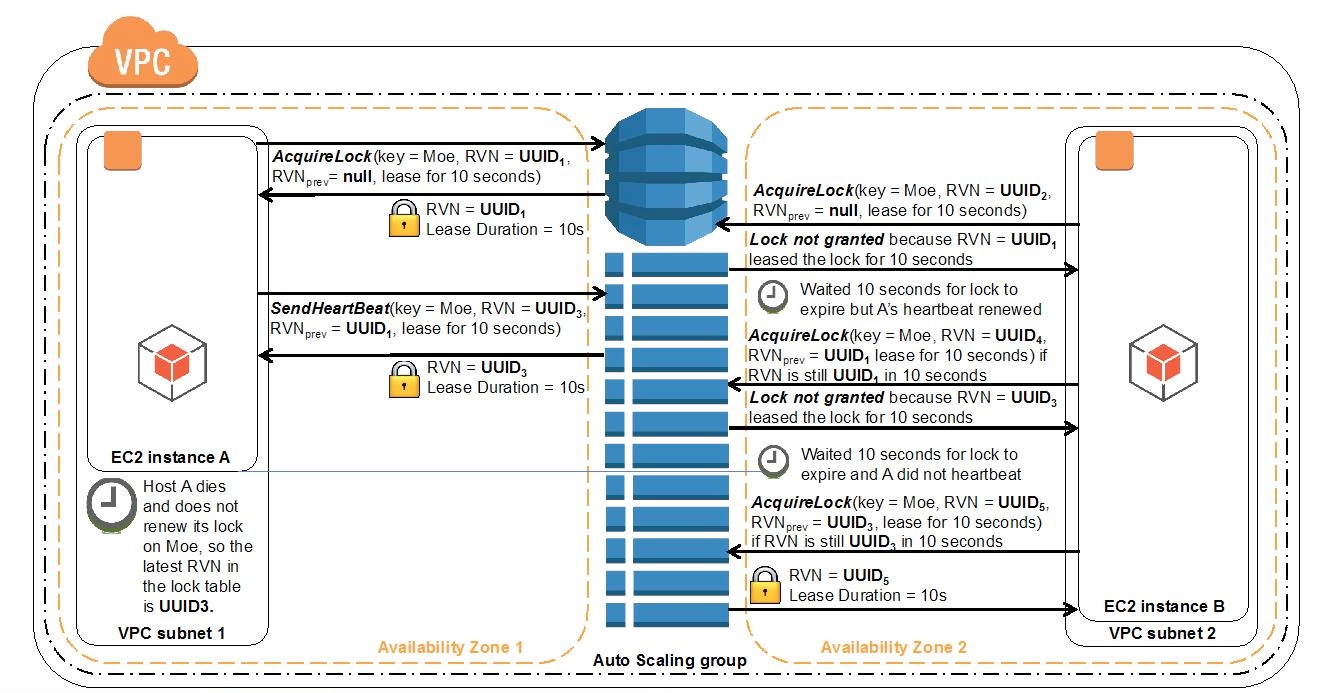Distributed Locks with the DynamoDB Lock Client
Distributed Locks with the DynamoDB Lock Client
1. Overview
DynamoDB Lock Client
- enable you to solve distributed computing problems like leader election and distributed locking with client only code and a DDB table
Why we need it
- Distributed Locking is complicated
- you need to atomically ensure only one actor is modifying a stateful resource at any given time
- Distributed Locking is complicated
2. Practical Example
- Background
- A retail bank that want to ensure at most one customer service representative change customer details at a time
- solution
- temporarily lock customer records during an update
- suppose there are bunch different tables to contain all customer information, as the tables are independent, so we cannot just wrap the changes we need in a relational transaction
- we need to lock customer id at a high level
- You’d do so with a locking API action for a certain duration in your application before making any changes.
2.1 Locking Protocol
- For a new lock, the lock clients store a lock item in the lock table
- it stores
- the host name of the owner
- the lease duration in milliseconds
- a UUID unique to the host
- the host system clock time when the lock was initially created
- it stores

- Host A acquires a lock on Moe by writing an item to the lock table on the condition that no item keyed at “Moe” exists yet. Host A
acquires the lock with a revision version number (RVN) of UUID. - Host B tries to get a lock on Moe with a RVN UUID.
- Host B checks to see if a lock already exists with a GetItem call.
- In this case, host B finds that host A holds a lock on Moe with a record version number (RVN) of UUID. The same application runs on hosts A and B. That being so, host B
expects host A to heartbeat and renew the lock on Moe in less than 10 seconds, if host A intends to keep the lock on Moe. Host A heartbeats once, and uses a conditional update on the lock keyed at Moe to update the RVN of the lock to UUID. - Host B checks 10 seconds after the first AcquireLock call to see if the RVN in A’s lock on Moe changed with a conditional UpdateItem call and a RVN of UUID.
- Host A successfully updates the lock. Thus, host B finds the new RVN equal to UUID and waited 10 more seconds. Host A died after the first heartbeat, so it never changes the RVN past UUID. When host B calls tries to acquire a lock on Moe for the third time, it finds that the RVN was still UUID, the same RVN retrieved on the second lock attempt.
- In this case, hosts A and B run the same application. Because host B expects host A to heartbeat if host A is healthy and intends to keep the lock, host B considers the lock on Moe expired. Host B’s conditional update to acquire the lock on Moe succeeds, and your application makes progress!
Reference
转载请注明来源,欢迎对文章中的引用来源进行考证,欢迎指出任何有错误或不够清晰的表达。可以在下面评论区评论,也可以邮件至 stone2paul@gmail.com
文章标题:Distributed Locks with the DynamoDB Lock Client
文章字数:516
本文作者:Leilei Chen
发布时间:2021-01-15, 11:51:14
最后更新:2021-01-15, 11:53:09
原始链接:https://www.llchen60.com/Distributed-Locks-with-the-DynamoDB-Lock-Client/版权声明: "署名-非商用-相同方式共享 4.0" 转载请保留原文链接及作者。

